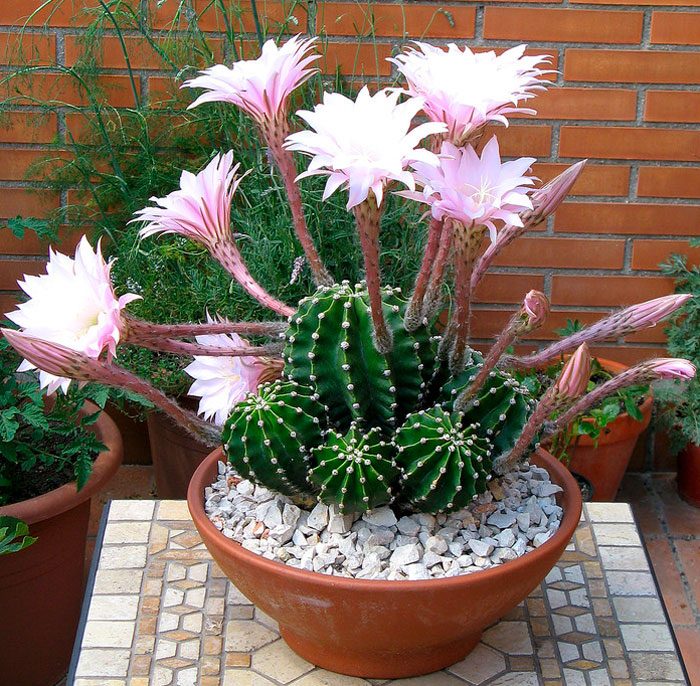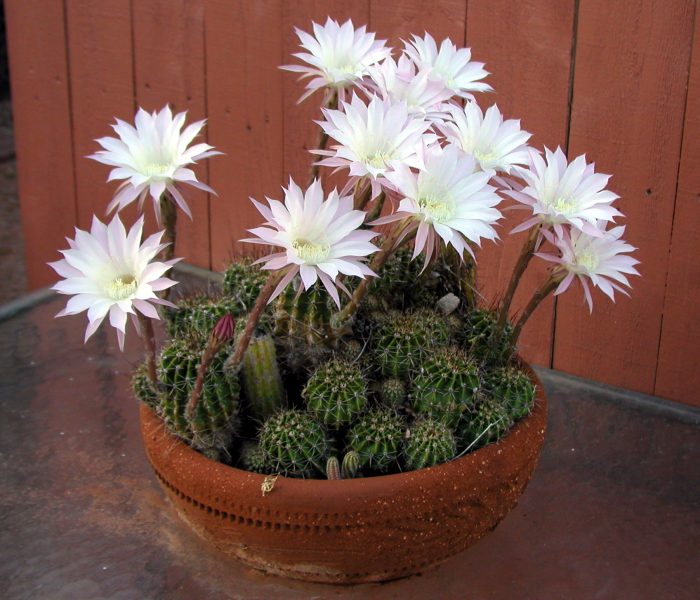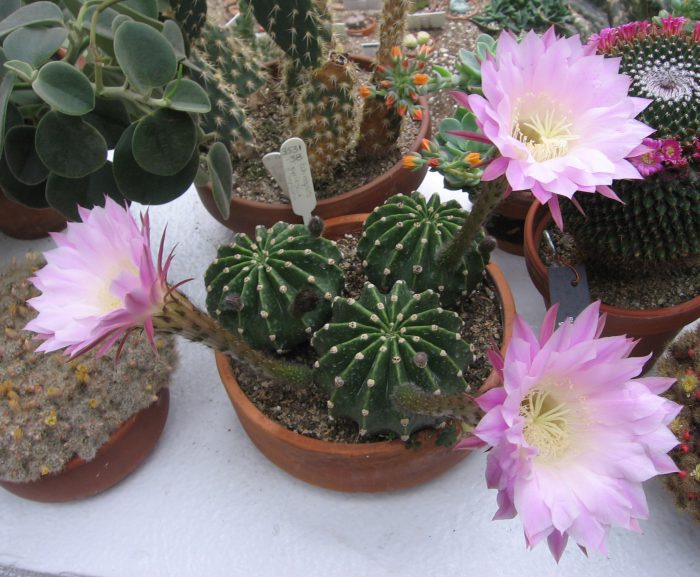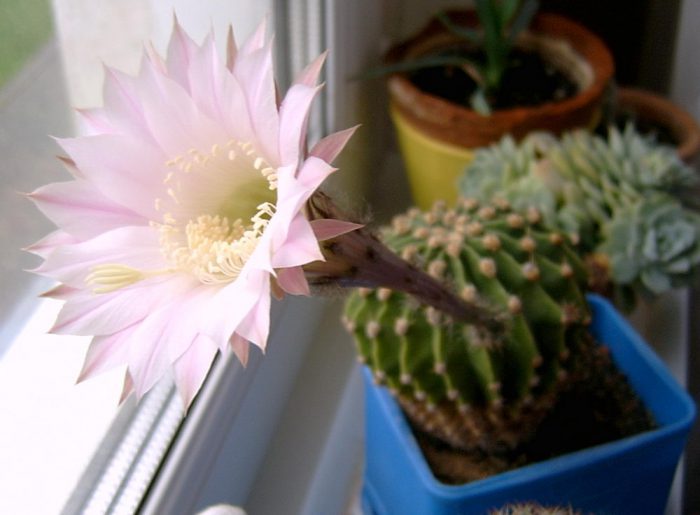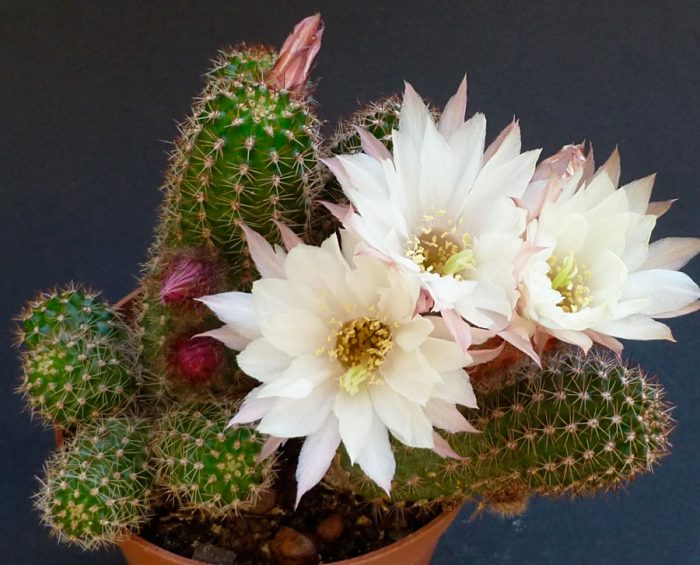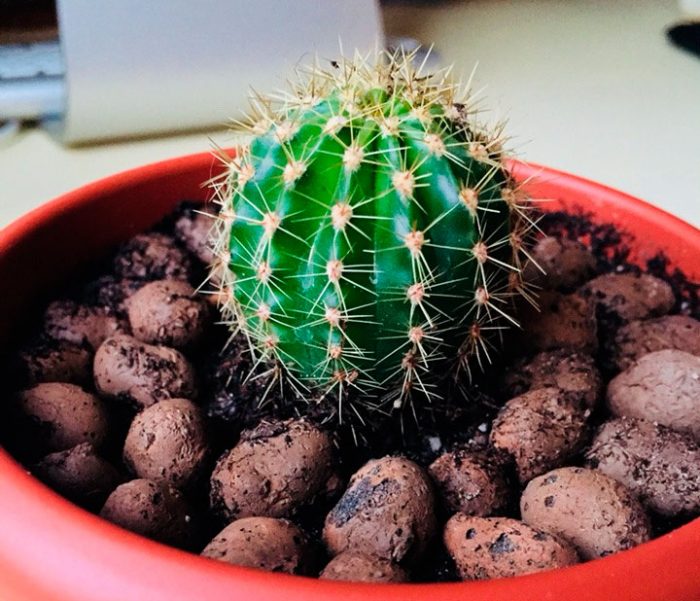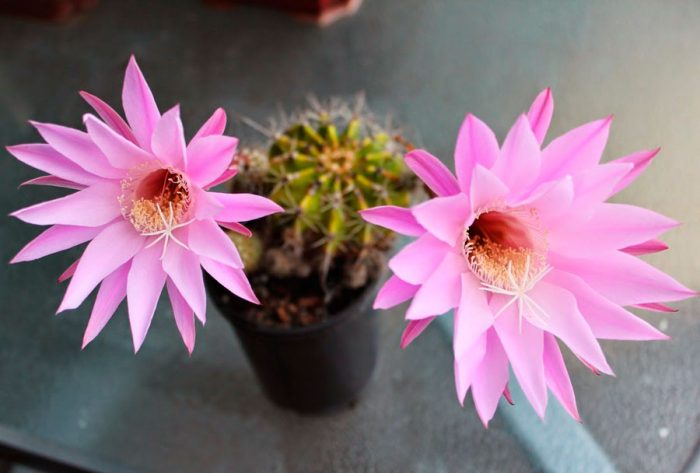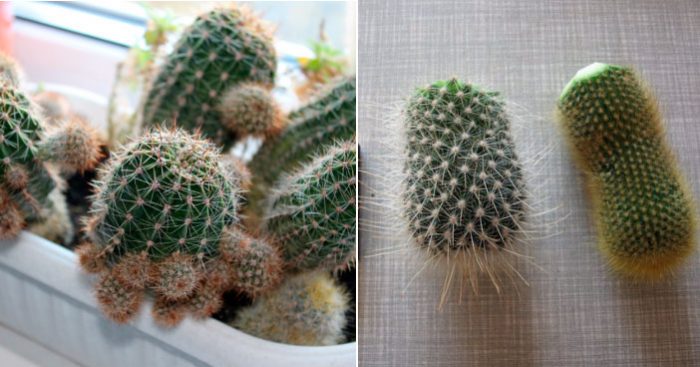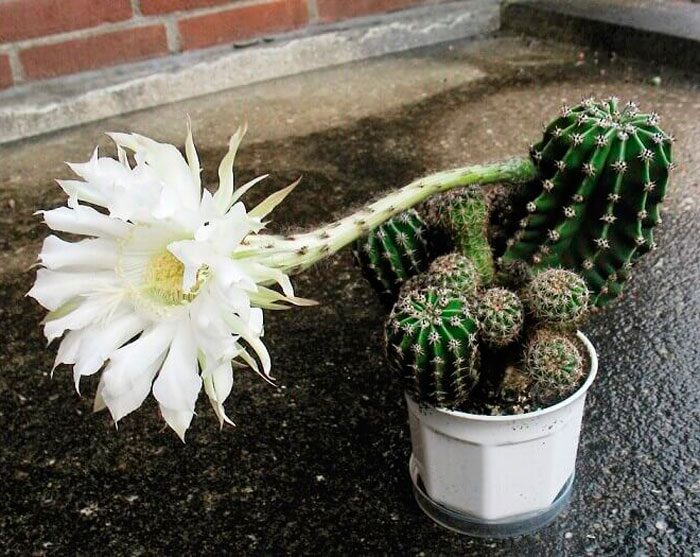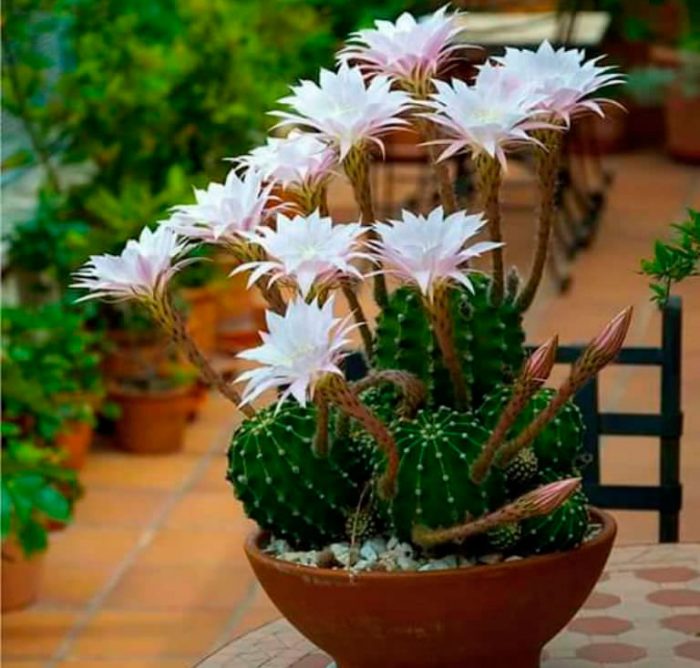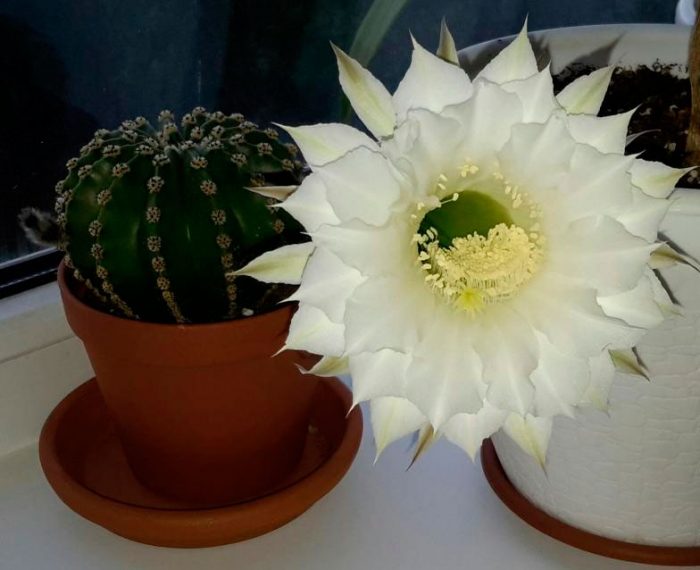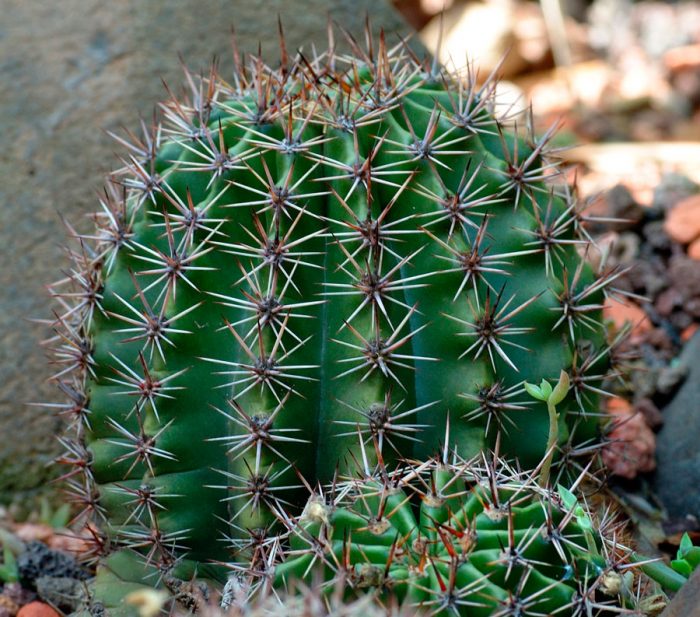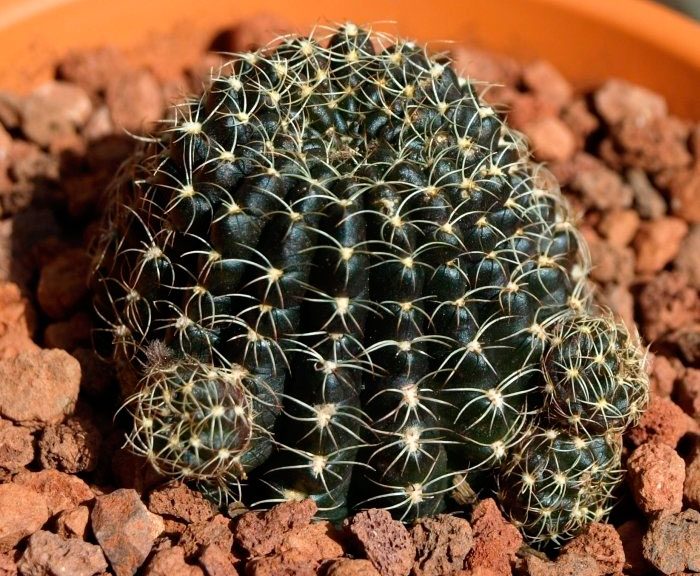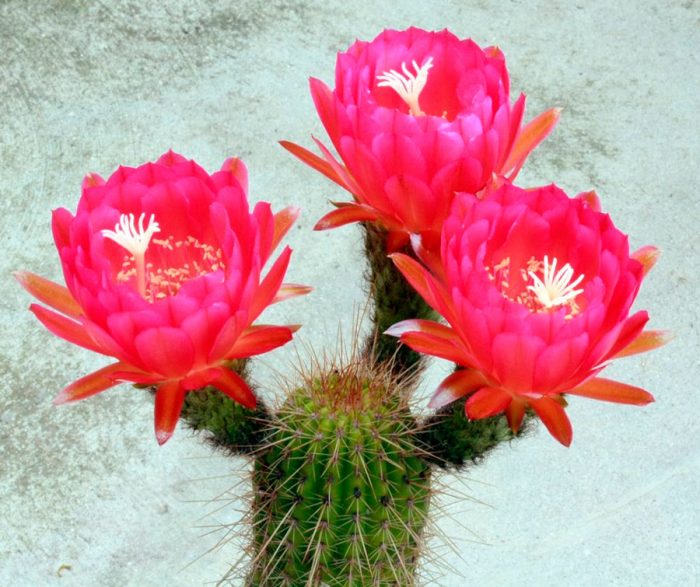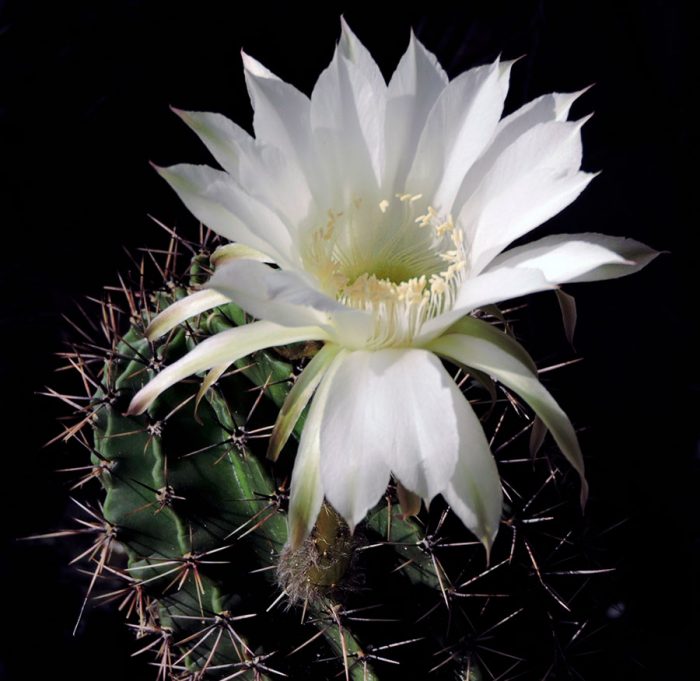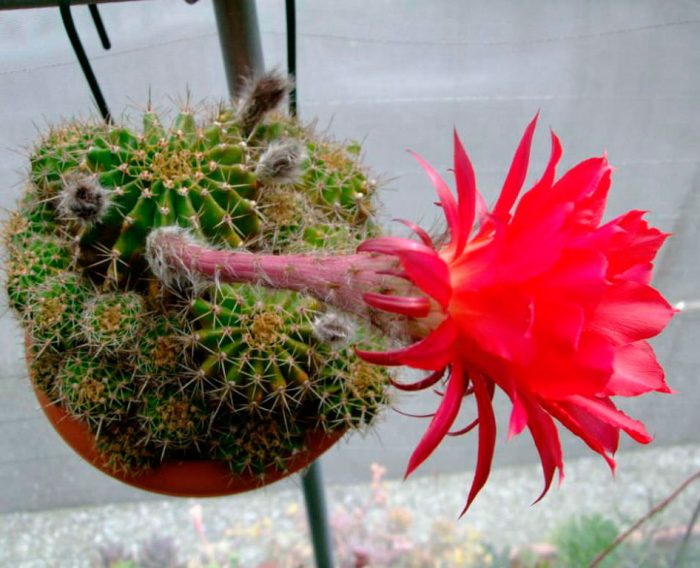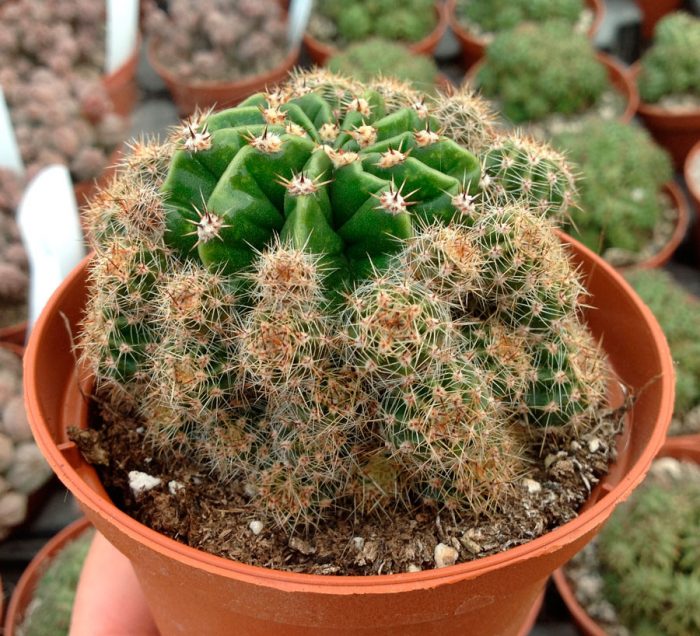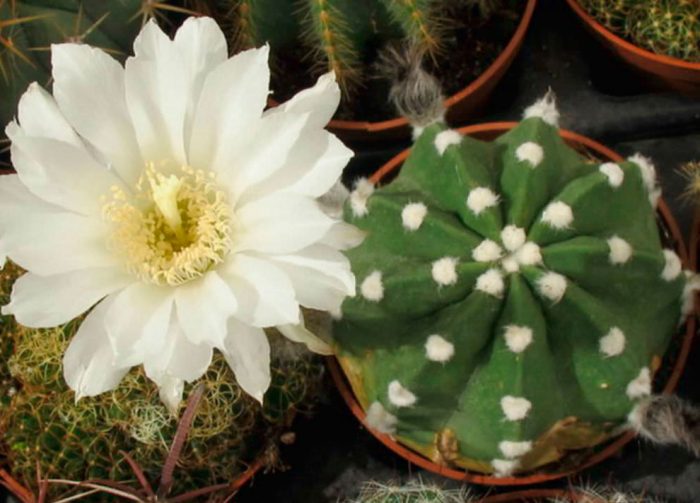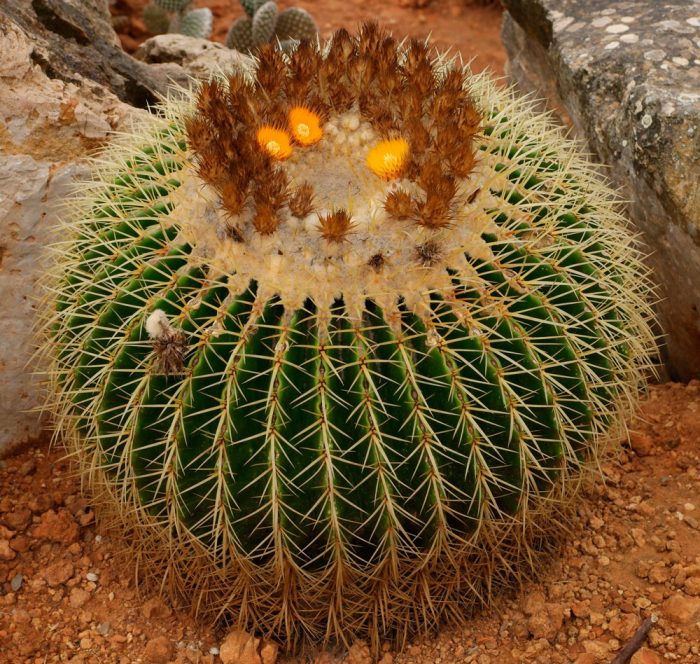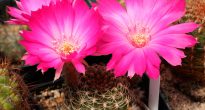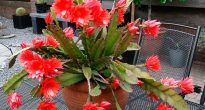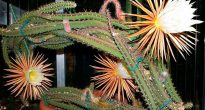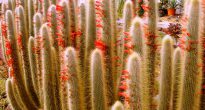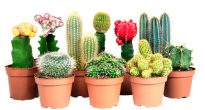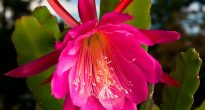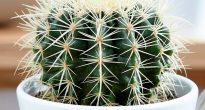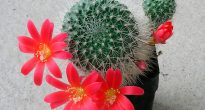The Echinopsis plant is a member of the Cactaceae family, which is very popular among flower growers. The name "echinopsis" comes from the Greek word and translates as "like a hedgehog." This name was proposed by K. Linnaeus in 1737; he believed that representatives of this genus are very similar to a spiny hedgehog curled up in a ball. In natural conditions, such a plant can be found in South America, as well as in the territory from North Bolivia to South Argentina, and also in Uruguay, southern Brazil, in the valleys and foothills of the Andes.
Among all cacti, echinopsis are most popular with flower growers. They appeared in the culture of European countries in 1837. Thanks to the work of breeders, today there are not only more than 130 species of this plant, but also many hybrid varieties that can be painted in a variety of colors.
Content
- 1 Brief description of cultivation
- 2 Features of echinopsis
- 3 How to care for echinopsis at home
- 4 Reproduction methods
- 5 Echinopsis pests and diseases
- 6 Types of echinopsis with photos and names
- 6.1 Echinopsis sharp-edged (Echinopsis oxygona)
- 6.2 Echinopsis eyriesii
- 6.3 Echinopsis tubiflora (Echinopsis tubiflora)
- 6.4 Echinopsis hook-nosed (Echinopsis ancistrophora)
- 6.5 Echinopsis golden (Echinopsis aurea)
- 6.6 Echinopsis huascha (Echinopsis huascha)
- 6.7 Echinopsis white-flowered (Echinopsis leucantha)
- 6.8 Echinopsis mamillosa (Echinopsis mamillosa)
- 6.9 Echinopsis multiplex
- 6.10 Echinopsis subdenudata (Echinopsis subdenudata)
- 6.11 Echinopsis grusonii (Echinopsis grusonii)
Brief description of cultivation
- Bloom... In the springtime. In some cases, the bush can bloom for about 6 months.
- Illumination... You need bright sunlight, so south-facing windows are great for echinopsis.
- Temperature regime... During the growing season, the room should be no colder than 20 degrees. And with the onset of autumn, it is recommended to lower the temperature to 9-10 degrees, but the light should be as bright as in summer.
- Watering... Moisten the soil mixture in the pot systematically immediately after it dries to a depth of ½ part. In winter, watering should be very sparse or not at all.
- Air humidity... It grows normally at the same level of air humidity that is typical for living rooms.
- Fertilizer... The plant is fed from March to September or October, for this, a mineral complex fertilizer for succulents and cacti is introduced into the substrate once every 30 days.At other times, you do not need to fertilize Echinopsis.
- Dormant period... From the second half of autumn to the last days of winter.
- Transfer... While the cactus is young, it is transplanted every year, and older specimens are subjected to this procedure less often, or rather, once every 2 or 3 years. It is not recommended to replant old and very large bushes; instead, they replace the top layer of soil mixture in a pot about 50 mm thick every year.
- Reproduction... Children and the seed method.
- Pests... Spider mites.
- Diseases... Rot.
Features of echinopsis
While Echinopsis is young, it has a spherical shape, but over time, its stem becomes more elongated and columnar. Glossy, smooth, symmetrical, sharp-ribbed stem, it can be colored in various shades from dark green to greenish. The strong root system is located horizontally and fairly close to the surface of the substrate. Areoles bearing hard spines are equidistant from each other. The length of the spines depends on the species, they are both short and can reach a length of several centimeters. During flowering, funnel-shaped flowers are formed on the cactus, the diameter of which is about 15 centimeters, and the length is up to 30 centimeters. They include many petals arranged in 7 rows, as well as a tube, on the surface of which there is pubescence. The flowers grow from the areola in the middle of the stem. Corollas can range in color from purple-pink to white. The number of flowers formed is influenced by both the health of the bush and how old it is: about 25 flowers can form on an old healthy plant at the same time. However, the lifespan of each flower is short and is 1-3 days (depending on the temperature in the room). Inside the ovoid fruits are glossy smooth black seeds.
How to care for echinopsis at home
It is quite simple to cultivate echinopsis indoors, and you need to take care of it in almost the same way as for other cacti. Such an unpretentious plant to care for is also undemanding to growing conditions. But in order for this cactus to grow and develop within normal limits, as well as bloom regularly and magnificently, it must be looked after according to all the rules.
Illumination
Such a cactus needs a lot of bright sunlight at any time of the year. That is why it grows best on a south-facing window. In summer, it is recommended to move the flower to fresh air (terrace, garden or balcony). But it should be borne in mind that while the bush is actively increasing its green mass, it is highly discouraged to disturb it. It is also not recommended to transfer to another place or just turn the cactus on which buds are formed or flowers bloom.
Temperature regime
During active growth, the cactus should be warm, make sure that the room is not colder than 20 degrees. From the second half of autumn, when Echinopsis begins a dormant period, the temperature in the room should be gradually reduced to 9-10 degrees. At the same time, remember that the bush needs bright sunlight both in summer and winter. Make sure that the cactus is not exposed to drafts. However, the room where it is located must be systematically ventilated.
Watering
Watering such a plant from spring to the second half of autumn is necessary regularly, but this is done only after the soil mixture in the container dries out to a depth of ½ part. In order to check how dry the substrate is, you need a thin stick made of wood, stick it into the pot, and then check the moisture content of the soil mixture on the stuck earth.
Echinopsis is poured with filtered or settled water from the tap, and its temperature should be close to room temperature.From the second half of autumn to the first spring days, the bush needs to be watered very rarely and with a small amount of water, but you can not water the flower at all at this time. Also, it does not need to be humidified from a spray bottle, since it grows normally with air humidity typical for living rooms. However, for hygienic purposes, it is still recommended to wash it sometimes under a warm shower, while using a soft bristled brush. Do not forget to cover the surface of the substrate with a film before showering so that no water gets on it.
Top dressing
They begin to feed the plant in March after the intensive growth of the bush begins, while fertilizer is applied to the soil mixture once every 4 weeks. For this, a complex mineral fertilizer is used for succulent plants and cacti in the concentration recommended by the manufacturer. From the beginning of the dormant period (in the middle of autumn), feeding is stopped, and they are resumed only in the spring.
Echinopsis transplant
Adult bushes do not need frequent transplants, they are carried out only if necessary, when the root system becomes very cramped in the container. As a rule, Echinopsis is transplanted once every 2 or 3 years. But while the cactus is young, it will have to be replanted more often. Experts recommend not replanting old and large bushes at all. Instead, they replace the top layer of soil mixture in a container about 50 millimeters thick with fresh substrate once a year.
For transplanting, use a neutral soil mixture (pH 6.0). Ready-made soil mixture for cacti, if desired, can be bought in a specialized store. You can also cook it yourself, for this combine coarse sand, sod and leafy soil, as well as fine gravel (2: 4: 2: 1). It is also recommended to add a small amount of charcoal to the finished soil mixture, this will help protect the plant's root system from rot. It is recommended to choose a pot for such a cactus low, but wide. The fact is that its horizontally located root system is superficial. At the bottom of the container, make a thick layer of drainage using expanded clay for this. Then the bush is carefully transferred from the old container to a new one along with a lump of earth. All voids in the pot are covered with fresh substrate, which is well tamped. When the transplant is complete, water the cactus abundantly. In the first days, the transplanted plant must be protected from direct sunlight.
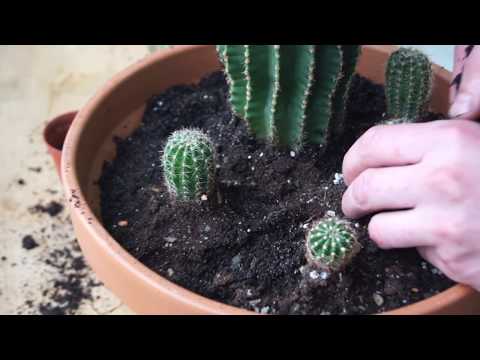

Watch this video on YouTube
Bloom
This cactus will surely delight you with spectacular fragrant flowers, if you take proper care of it and provide it with optimal conditions for growth. Echinopsis flowers are very beautiful, but its buds are also quite spectacular. One thing can upset the grower that this cactus blooms for a very short time.
It may happen that flowers do not appear on an adult bush. In this case, you need to try to understand whether you are caring for the plant correctly, and whether it grows under suitable conditions. Remember that for a lush flowering, Echinopsis needs proper wintering at an air temperature of 5 to 10 degrees. It also needs a lot of bright, diffused sunlight all year round. In addition, children must be removed from the bush in a timely manner, because they take a large amount of strength and nutrients from the parent plant, which has an extremely negative effect on flowering.
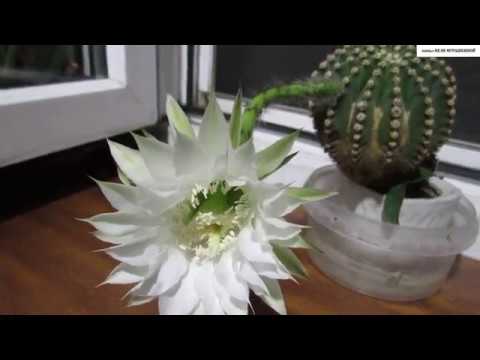

Watch this video on YouTube
Reproduction methods
Echinopsis in indoor conditions can be propagated in two ways: by seeds and daughter processes.
Growing from seeds
Immediately before sowing, the seed must be poured with warm water for a while so that it swells. Take a small container and fill it with a damp soil mixture of charcoal, leafy soil, and river sand (1: 1: 1). Sow prepared seeds and cover the container with foil or glass.Remove crops in a well-lit place where the air temperature will be 19-20 degrees. Crops need regular ventilation, which is carried out every day, as well as timely moistening of the substrate. Remove condensate from the shelter if necessary. Immediately after the first seedlings appear, remove the shelter from the container. When the seedlings grow up and get stronger, they should be cut into individual, not very large cups.
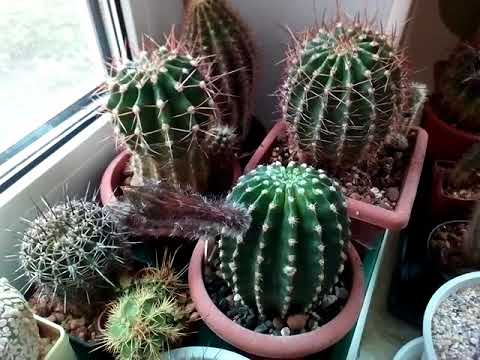

Watch this video on YouTube
Reproduction by children
Also, this cactus can be easily propagated by daughter shoots that grow directly on the parent bush. It happens that a lot of children grow up on one adult echinopsis. After the baby is separated, it should be left in the open air for a while to dry. Only after that is it planted in a separate pot. But remember that bushes propagated in this way will flower less often.
Rejuvenating the old bush
If the cactus is already very old, then it is recommended to rejuvenate it, and this procedure is combined with vegetative reproduction. To do this, very carefully cut off the top of the bush and leave it outdoors for half a month so that it can dry well. Only then is it planted in moistened sand for rooting. The part of the bush that remains in the pot after pruning will also continue to grow, and a large number of young shoots will appear on it.
Echinopsis pests and diseases
Diseases and treatments
The echinopsis plant is very resistant to diseases and harmful insects. However, if the irrigation regime is violated in the soil mixture, regular stagnation of water can be observed, which leads to decay of the bush. All problem areas should be cut out as soon as possible, using a very sharp pre-disinfected instrument. Then do not forget to treat the cut points with a fungicide solution. However, it is very simple to avoid the appearance of rot on a cactus, for this it needs to be very sparsely and rarely watered during active growth, and not to moisten the substrate in the pot at all throughout the growing season.
Pests
As a rule, a spider mite prefers to settle on Echinopsis, which feels great at low air humidity. This pest is a sucking pest, it pierces the tissues of the plant and sucks out the juice from them. You can understand that “uninvited guests” have settled on the bush by looking at the thin web on its surface. If there are few pests, then getting rid of them will not be difficult. To do this, thoroughly rinse the bush with a soap solution, having previously protected the surface of the soil mixture with a film from the ingress of liquid. In the event that such a treatment turns out to be ineffective, then you will have to spray the bush with Fitoverm or Actellik solution. Experienced flower growers recommend choosing the least toxic agents for the treatment of echinopsis, and the treatment should be carried out in the open air.
Types of echinopsis with photos and names
Today, in indoor conditions, hybrid varieties of Echinopsis are most often found. But sometimes you can still meet specific plants. Below will be described those varieties, species and hybrids that are most popular with flower growers.
Echinopsis sharp-edged (Echinopsis oxygona)
This green plant has a spherical shape, it has 8-14 rounded ribs. In diameter, the bush can reach 5-25 centimeters. On the surface of the stem are white areoles with needle-shaped central spines of light color, the number of which can vary from 3 to 15 pieces. The flowers are about 22 centimeters long and can be pinkish-red or pink. The length of green fruits is about 40 mm, and in diameter they reach up to 20 mm.
Echinopsis eyriesii
This plant has a ribbed stem colored in a dark green hue.On the surface of the ribs there are areoles with small fluffy balls of light color, from which short styloid spines grow. In length, the flowers can reach about 25 centimeters, their color is pinkish or white, sometimes the petals are decorated with a strip of dark pink color, located in the middle of them. In this species, as a rule, a large number of daughter processes are formed.
Echinopsis tubiflora (Echinopsis tubiflora)
While the bush is young, its stem has a rounded shape, which eventually becomes cylindrical. On the stem are clearly distinguishable ribs with deep grooves in the amount of 11 or 12 pieces. Areoles in this species can be gray, white or black. The tops of the yellowish spines are dark in color. One areola can have 3 or 4 central spines, which are about 35 mm long. Also, up to 20 radial needles with a length of about 25 mm grow in the areola. The length of the funnel-shaped flowers is about 25 centimeters, and in diameter they can reach up to 10 centimeters, the petals are white in color.
Echinopsis hook-nosed (Echinopsis ancistrophora)
The stem is spherical and flattened at the top and bottom, in diameter it can reach up to 80 mm. There are ribs on the stem, on which you can see clearly distinguishable tubercles. From areoles of light color, 3-10 radial spines of white or light shade grow, they are spreading and bent back. The length of such spines is about 15 millimeters. As a rule, there is only one central spine, reaching about 20 millimeters in length, it is brownish, and its top is hooked. On the lateral surface of the stem in the daytime, flowers bloom, which have a length of about 15 centimeters and are completely odorless. Their petals can be painted white or in various shades from red to pink. Greenish-purple or purple fruits reach up to 10 mm in diameter, and their length is about 15 mm.
Echinopsis golden (Echinopsis aurea)
While the plant is young, its stem has the shape of a ball, but after a while it changes to a cylindrical one. Moreover, the height of the stem can be equal to about 10 centimeters, and in diameter it will reach 4-6 centimeters. On the dark green stem, there are 14 or 15 high, clearly distinguishable ribs, and areoles with brown pubescence are formed on them. From one areola, up to four central spines can grow, which are about 30 mm long and about 10 lateral needles, which are about 10 mm long. Such a plant forms a large number of basal shoots. In the middle or in the lower part of the stem, bell-shaped flowers appear in summer, reaching up to 80 mm in diameter. Their perianth is bristly, the tube is short, and the petals, which have pointed tops, are painted in an orange-yellow tint. The cut fruits are oval in shape.
Echinopsis huascha (Echinopsis huascha)
In this hybrid, the stems of a dark green color can be curved or straight, and their height varies from 0.5 to 0.9 m, and in diameter they can reach from 50 to 80 mm. At the base, such stems branch very strongly. The stem has 12 to 18 ribs, on the surface of which there are brownish-white areoles with pubescence. Each areola grows 1 or 2 median needles about 60 mm long, as well as from 9 to 11 lateral spines shorter (about 40 mm). During the flowering period in the daytime, flowers bloom, the length of which varies from 70 to 100 mm. They can be painted in various shades from bright red to deep yellow. In diameter, the fruits reach about 30 mm, and their color can be red or yellow.
Echinopsis white-flowered (Echinopsis leucantha)
The greenish-gray stem can be short-cylindrical or round; it reaches about 12 centimeters in diameter and up to 35 centimeters in height. It has 12–14 ribs, which are obtuse and tuberous.From yellowish-white areoles of an oblong shape, from 8 to 10 radial needles of a brownish-yellow shade grow, having a length of about 25 mm, as well as 1 median spine bent upwards, its length varies from 50 to 100 mm. During flowering, snow-white flowers appear on the top of the stem, and their length can be up to 20 centimeters. Fleshy fruits of a round shape are colored dark red.
Echinopsis mamillosa (Echinopsis mamillosa)
The flattened stem is colored dark green, its height is about 13 centimeters. It has 13 to 17 sharp ribs, on which there are distinct tubercles and deep grooves. Areoles are rounded, of which 1–4 median yellow needles with brownish tips, 10 mm long, and 8–10 radial awl-shaped needles of the same length grow. Slightly curved, funnel-shaped flowers are painted in a snow-white color, and the tops of the petals are pale pink. The flowers are about 15 centimeters long, and their diameter is up to 8 centimeters. The shape of the fruit is spherical.
Echinopsis multiplex
The stem is in the shape of a ball, widening downward, and its height is about 15 centimeters. It has 12 to 15 ribs. From areoles with white pubescence, 2–5 median spines grow, the length of which is about 40 mm, as well as 5–15 radial needles of a pale yellow color, which are about 20 mm long. The funnel-shaped fragrant flowers reach about 15 centimeters in diameter, they are painted in a whitish-pink color.
Echinopsis subdenudata (Echinopsis subdenudata)
Echinopsis is either half-naked, or Echinopsis is almost naked. The plant has a small size, and it is often used to create phytocompositions. There are practically no spines on the surface of the stem. Large flowers are white.
Echinopsis grusonii (Echinopsis grusonii)
The homeland of such a flower is Mexico. The dark green shiny stem has the shape of a ball, but after some time it changes to a barrel-shaped one. The width and height of such a plant can be up to 100 cm. If the conditions for its cultivation are ideal, then it does not bush and does not form daughter shoots. In an adult bush, about 40 sharp ribs are formed, on the surface of which densely sitting areoles with pubescence are located. In the upper part of the stem, the areoles join and form a pale yellow “cap”. One areola grows about 4 median needles up to 50 mm long, and about 10 radial spines of a golden hue, about 40 mm long. Popularly, this species is also called "golden ball" or "golden barrel", this is due to the contrast that is created by golden needles and a dark green stem. In the last spring or first summer weeks, flowers bloom at the top of the stem of a bush not younger than 20 years old, which reaches at least 0.4 m in diameter. They are solitary yellow, reaching about 50 mm across and up to 70 mm long. On the surface of the flower tube there is a tomentose pubescence, and it also has a large number of lanceolate petals with elongated tops of a brownish-yellow hue.
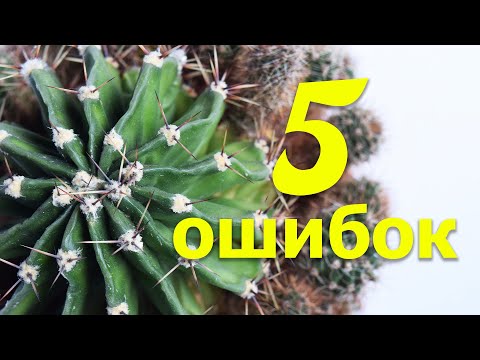

Watch this video on YouTube

